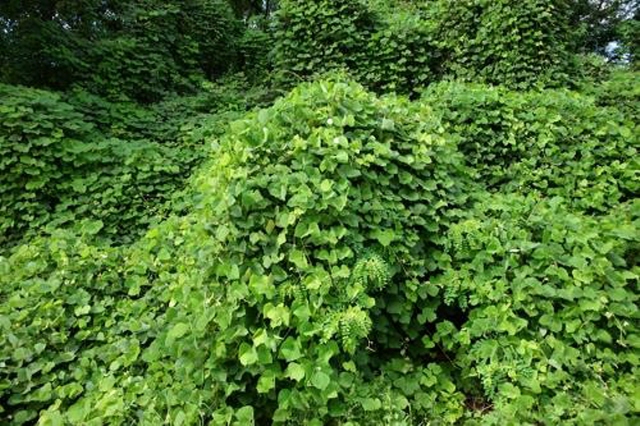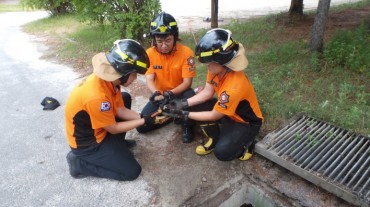
Kudzu vines grow well under sunlight, with strong durability and a rapid growth rate of 30 centimeters per day. (Yonhap)
MUAN, Sept. 26 (Korea Bizwire) — A South Korean research team has discovered a new method for the complete eradication of kudzu vines, an invasive species that is known to devastate local forests and plants.
The Jeonnam Forest Resource Research Institute announced on Wednesday that it has discovered a method to locate and remove the growing point of the vines, which effectively kills the root of the kudzu plant.
Kudzu vines grow well under sunlight, with strong durability and a rapid growth rate of 30 centimeters per day.
The vines quickly stretch by more than 100 meters each year, covering nearby forests and plants which obstruct them from engaging in photosynthesis, eventually causing them to die.
The vines are perennial plants that can regrow cut-off stems and reproduce by scattering seeds in autumn, which requires a lot of manpower and investment to remove them completely.
The Korea Forest Service began removing kudzu vines that are proliferating across 77,000 hectares in South Korea by investing 117.9 billion won (US$98.3 million) this year.
The institute has been researching the new method of removing kudzu vines since last year.
While using chemicals is seen as the best way to remove the vines, this comes with the risk of destroying the local ecosystem, which called for an alternative solution.
The institute discovered that the vine’s crown root is the plant’s growing point, and is continuing to research the most effective time frame and frequency of removing the vine’s growing point.
The crown root is located between the vine’s root and the stem, from which the stem grows upwards.
There have been a series of studies on the effective removal of the crown root using a variety of drugs and chemicals, as well as physical methods to locate and cut off the growing point in the vine’s crown root.
So far, a total of 13 methods to remove the vine’s growing point have been tested at a field site in Boseong County this year, which revealed that locating the crown root takes up the majority of time spent in the removal process.
Based on the results, the institute is conducting follow-up studies to develop a more efficient way to locate the crown root, and the frequency and timing of when the removal should take place.
“We were able to find the most guaranteed and efficient way of removing the vines by looking into their behavioral characteristics,” said Oh Deuk-sil, a departmental head at the Jeonnam Forest Resource Research Institute.
M. H. Lee (mhlee@koreabizwire.com)



![[Kobiz Feature] Aroma Candle, a New Popular Item for New Age Consumers [Kobiz Feature] Aroma Candle, a New Popular Item for New Age Consumers](http://koreabizwire.com/wp/wp-content/uploads/2014/04/16366953_9e24a602b5_z-370x246.jpg)


